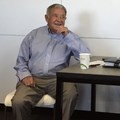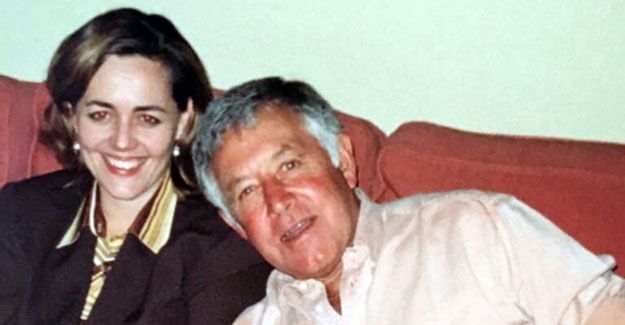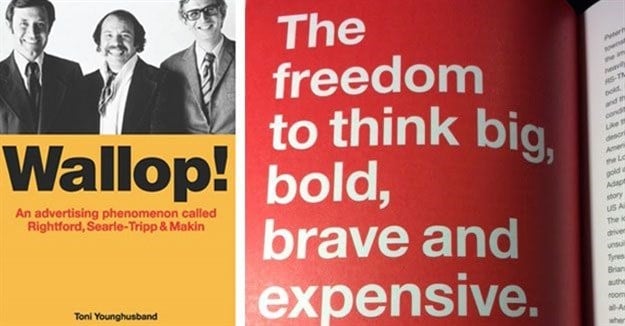
Honouring Bob Rightford: 10 lessons for agencies and marketers

Here's the post, originally published on Monday, 26 January 2015:
10 lessons for agencies and marketers, from three ad veterans
I read Wallop recently, the recollections of Bob Rightford, Brian Searle-Tripp and Roger Makin about the ad agency they built: Rightford Searle-Tripp Makin (RSTM). The agency became Ogilvy Mather-RSTM and is now simply called Ogilvy.
Disclaimer - Bob Rightford is my father in law.
In my 25+ years in the ad business, I didn't ever work for the company, either during Bob's tenure or after his retirement. I did, however, work for a few of their competitors. So reading the book was like peering in through a window. It was fascinating to look inside, from the outside.
What is also fascinating is to use the book as a then and now comparison.
No-one can deny they not only made great creative ads, they also helped their clients build strong brands and strong businesses. If you go to the Golden Oldies page of the website, it truly is a chronicle of the foundations of some of our biggest and most loved brands.
What? Creative ads that also built business? I cringe when I hear marketers expressing surprise or cynicism in that notion. Firstly, a creative ad is only great if it achieves the objectives set out in the brief. And secondly, there is more than enough evidence (see the research in The Case for Creativity) that creative ads have a far better chance of achieving better commercial results. So it should be a no-brainer for businesses to want the best creative from their agencies. And for agencies to constantly strive to provide groundbreaking ideas.
And yet, at the nub of so many agency-client relationship issues is this notion of the agency not "adding value", not bringing "thought leadership" nor "business building ideas" to their clients. Many marketers feel that their agencies simply don't understand their business and aren't business focused enough. Bear in mind that CEOs of businesses even feel their CMOs aren't business focused enough! (See this Fournaise research). So the disconnect from CEO to CMO to agency, and ultimately to the creative output and the agency-client relationship, is massive.
What Wallop shows us is that RSTM managed to connect rather than be disconnected. They formed deep relationships with their clients, many of which persist to this day, long after Bob, Brian and Roger retired. They built a company culture, one which the current Ogilvy team respects and builds upon. They attracted great people. They did great work. The work they did created foundations for brands that grew from strength to strength. And because of all that, and a few other things they got right, their agency grew from strength to strength.
So how did they achieve this Holy Grail?
I took some lessons out of the book - looking at what they did then, in the light of some of the challenges the industry faces now. Sure, the industry is different and remuneration models are tougher and client structures are harder to crack and people are busier and labour law is more stringent and.... There are loads of reasons why it could be said that it is much harder to succeed in advertising now than it was then. And yet. And yet... There are agencies that are succeeding. And I would hazard a guess that the lessons I gleaned, listed below, will be old hat to them. Different era, same principles.

Here are the lessons, in no particular order, I digested from the book. I think they're important for the industry of today - both marketing side and agency side.
1. Strong connection with the CEO and marketing director
The relationship between Bob Rightford and the CEOs of their client's companies, as well as the Marketing Directors, was strong, close and even bordered on brutal honesty. There was no kowtowing and second guessing. The depth of these relationships allowed for difficult conversations, allowed for respect to grow, and allowed for the right work to be produced.
Over the years an insidious culture has crept into the industry that CEOs are too important for marketing issues, and particularly advertising issues. Agency MDs and CEOs bemoan they have lost their seat at the Top Table. So, the relationship has been pushed further down and it lands somewhere at Marketing Manager-Account Director level. This is fine on a functional, timeline, project management basis, but it certainly won't build the kind of business successes that a strong relationship further up, or right at the top, will.
Another odd notion amongst agency account management or MDs that their job is "to keep the client happy", to not rock the boat, in case they lose the business. The irony is if they continue with that approach, they will lose the business anyway.
An agency is not there to keep the client happy. The agency is there to do great work which helps the client company achieve their marketing objectives. Sometimes, because of the subjective nature of creativity and innovation, that requires some boat rocking. And Wallop tells plenty of stories in that regard. All with happy endings.
2. Absolute loyalty to client's products.
Bob Rightford retired in 1995. Twenty years later, to this day, he remains fiercely loyal to his former clients' brands. And this brand loyalty was expected from everyone at RSTM.
Of course, not only is this polite, but it turns agency staff into consumers. The insights gleaned, the selling cycle, the product highs and lows are experienced by the people working on the business. It also takes you further into the clients value chain, into the real understanding of issues that might affect the consumer. You will seldom get this in a brief. The example in the book about VW's dealers and the campaigns they developed to help them as businesses too, is a great example, particularly as the agency had to fight hard to get it made.
3. A deep understanding of the client's business, on every level and in every channel. No lines.
This follows on from the point above. But it was more than that. A slavish devotion to understanding every aspect of the client, from factory visits to store visits, competitive analyses (actual, on foot, not just Google), speaking to other channels in the selling cycle, like Dealers in the example above.
This built the ability to develop powerful insights. It allows the agency to access insights into the purchase behaviour of consumers that clients may be too close to, to see. Great campaigns usually have a cracker insight at their core. Also out of insight comes proactivity. Insights inspire new product concepts, new angles to address problems, new distribution options. And here's the thing - far from losing the business by forcing your clients to confront unpleasant truths, you not only help build their business, but also build the agency's business. In effect the VW Dealers became a new client, with additional revenue opportunities for the agency.
Too many agencies rely on their clients to give them insights. Too many marketers rely on their "Insights department" to give them insights, which is often just information. Too many of us are using the internet, or big data or third party research to tell us what people are doing. If you as an agency member are actively using, buying, driving, drinking your client's product every day, and making sure you watch others who do too, you'll be certain to stumble across an insight or two, way quicker than from behind your desk.
This deep understanding of the business your client is in, is also so critical in today's multi-channel communications era. No longer is it simply above- or below- the line. Now we have a million more silos. Digital. Social. Experiential. Activation. Shopper. Retail. Online, offline. Third screen. Fourth Screen. And you know what - the consumer doesn't see it that way. There is no line. Only a consumer wanting, or not, to buy something.
4. Proactivity is not a cute tactical ad. It builds value for the client company. Business value.
The best example of this in the book, and there are many, was the creation by the agency of the Citi Golf concept. Like the VW Dealership campaign, the agency fought for this, based on a real understanding of the market and a nose for opportunity. Asking "What if?" Not only did it build immense value for the client over many years, it again built a new revenue and creative opportunity for the agency. Oh, and created a brand that South Africans adored. Watch how consumers said an emotional goodbye when eventually VW discontinued the Citi Golf:
5. They looked after their most important assets - their people.
Bob says they liked to say that their most important assets went down the elevators and out the front door at night. Wallop tells the story of a company that looked after their people. Were they relentless? Yes. Were they demanding and did they fire people? Sure. But it seems they did a few things right.
One, they created a culture where mavericks wanted to work. They attracted them and then they hired them when no-one else would. Agencies are not "corporates" and despite the best efforts of global holding companies and accountants in trying to turn them into corporately behaved businesses, they can't be, shouldn't be and won't ever be.
More than this they looked after their people - one example was when they fired a big big big Client because the junior marketing person was slowly sucking the life out of the creative department refers. Your people are your assets. And if they're depressed, your asset loses its immense value.
In my Adtherapy work, I see people in agencies dying in the trenches without management support. I see account management being mowed down by rude and disrespectful (and unskilled) clients; I see creatives with hunched shoulders, working till 3am night after night and being expected to be creative the next day. This cannot be. The success of any agency lies in keeping your talented people inspired and motivated (and employed by you not your competitor). Sometimes this means you have to go to war for them.
RSTM helped their people grow too. They invested in training. They ran successful workshop programmes which not only allowed people to bond and create friendships but also to hone their skills. Sadly in many agencies this is an expense that has been cut. Talk about not doing the cost-benefit analysis properly. Better skills make better business.
Another aspect of looking after their people was building a culture in which every person felt they played a part. An open attitude to where ideas come from. A shared interest in the campaign being sold and working well. Too many agencies use polarising language that put people in siloes. Like creatives talking to account management about "Your client", and account management discussing "Your work" with creatives. This book highlights a time and a culture where everyone was invested in the client getting the best work. Everyone cared. So the clients did, too.
6. Strong, focused (and aligned) leadership.
This was an interesting one, because it plays out so well in the agencies that are successful today. Strong leadership is required in order to have the difficult conversations that are so necessary in this business, both internally and with clients, suppliers and others. But aligned leadership is even more important. The leaders at the top being on the same page.
Bob says "we knew the type of work we wanted to do, and worked together to make that happen". It was never about the money, or keeping business, or meeting budgets. It was about the work. And that was across the board. Too many account management and MDs in my opinion believe its okay to throw the work under the wheels and rather do what the client wants. "Keep the peace and collect the cash". Short-term thinking.
7. A company-wide commitment to aim higher than you ever thought was possible.
This comes through in the commitment to "the work, the work, the work". It was quite simply all about the work. And the question was asked - is it good enough? Work was developed, it was crafted, it was made better. Always. And the best suppliers, the best film makers, the most impossible ideas were made possible. Which made them great.
Somehow in this era of time-sheets and budget cuts and reduced margins, this commitment and passion for excellence falls by the way. Work is "okay" enough to leave the building. There's an air of compromise. Suppliers are chosen based on staying in budget. And maybe that's just the way of the world. But funnily enough, big ideas generally make big returns that make up for the expense upfront. Not just in advertising - in business. But it takes courage to motivate for that upfront investment. Lesson: be bold and brave. Be courageous.
8. An ethical compass - politically and personally.
The book starts with how Bob got fired from a previous company for what was deemed to be a 'bribe'. This drove his unwavering enforcement of ethics in the company that he, Brian and Roger sought to build. Their ethics came through in how they treated people, it came through in wanting to do the right thing politically, it came through in ensuring that the agency was above board in everything they did.
What agencies don't always understand is that their clients are distrustful of them anyway. Advertising is expensive. Clients imagine that agencies are crooking the books. Dodgy business practices seek only to weaken the industry and have no place in the relationships that need to be built in order to get great work.
9. Fun, more fun and then more on top of that.
People who have never worked in advertising think it's one long party. In fact I had a rule never ever to hire anyone who started an interview with "I've always wanted to work in advertising". It's a relentless, tough, ego-smashing, challenging, sometimes impossible, sometimes soul destroying, job, and it takes a certain type of person to thrive and excel in that space.
It involves long hours and lots of arguments and tempers and yet there is also lots of laughter. People who work in advertising generally have great senses of humour (thank heavens). Part of RSTM's success was creating an environment where people could have fun. Where they could let their hair down, and laugh or cry and run naked across the rooftop, then dust themselves off for another great day at the office.
10. They made money.
Agencies have a tough time these days in between being told what their hourly rates can be, what deliverables they can and can't charge for, how big the logo should be, in addition to marketing budgets being divided amongst more and more specialist agencies or going in-house. Applying all of the nine points above would be pointless without making enough money to pay your talent well, have decent premises, invest in training and inspirational activities and grow a great business.
What comes through in Wallop is that their mission was never "how do we get rich"? There was never a plan to build a great culture because that would make them money. Instead there was a fanatical obsession with making the very best advertising they could for their clients, and an obsession about helping their clients solve their business challenges. And that, in the end, helped them make money.
Valuable lessons. So, those are ten thoughts from three veterans who were part of putting South Africa on the international map of advertising, that I feel are useful to ponder. I'm sure there are more.
Read the book, reminisce about ads you (or your parents) might remember on the website.
But above all, think about the basic principles:
Agency: Focus on the creative product and look after your people.
Marketer: Invest in relationships with your ad agency at the top and let them be creative.
Both: Be courageous.
All else will follow.
About Gillian Rightford
- 3 steps for effective account leadership - 10 Aug 2023
- #BizTrends2023: More heart - a micro trend that will make a mega difference - 9 Jan 2023
- #BizTrends2020: Creativity's tipping point in business - 20 Jan 2020
- Asking the right questions means that you answer the right question - 29 Jan 2019
- #BizTrends2018: It's not on top, it's inside - 2 Feb 2018
View my profile and articles...